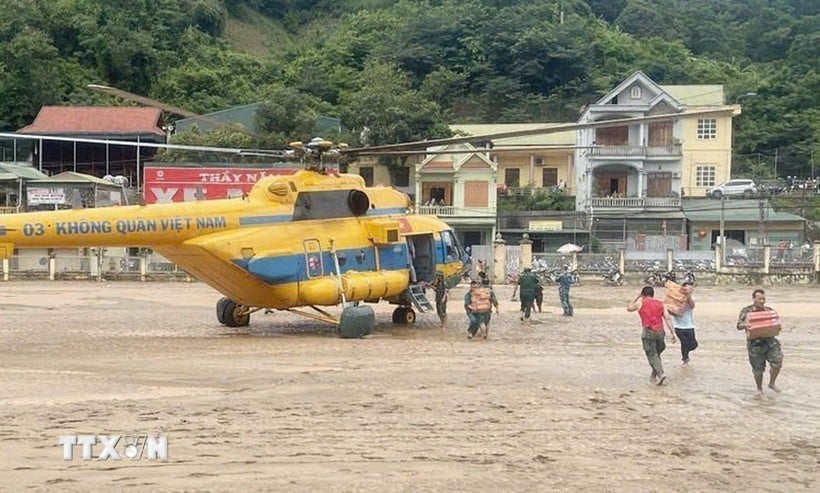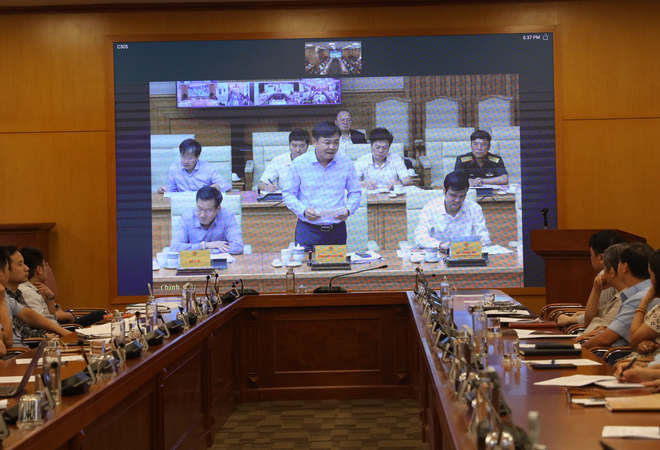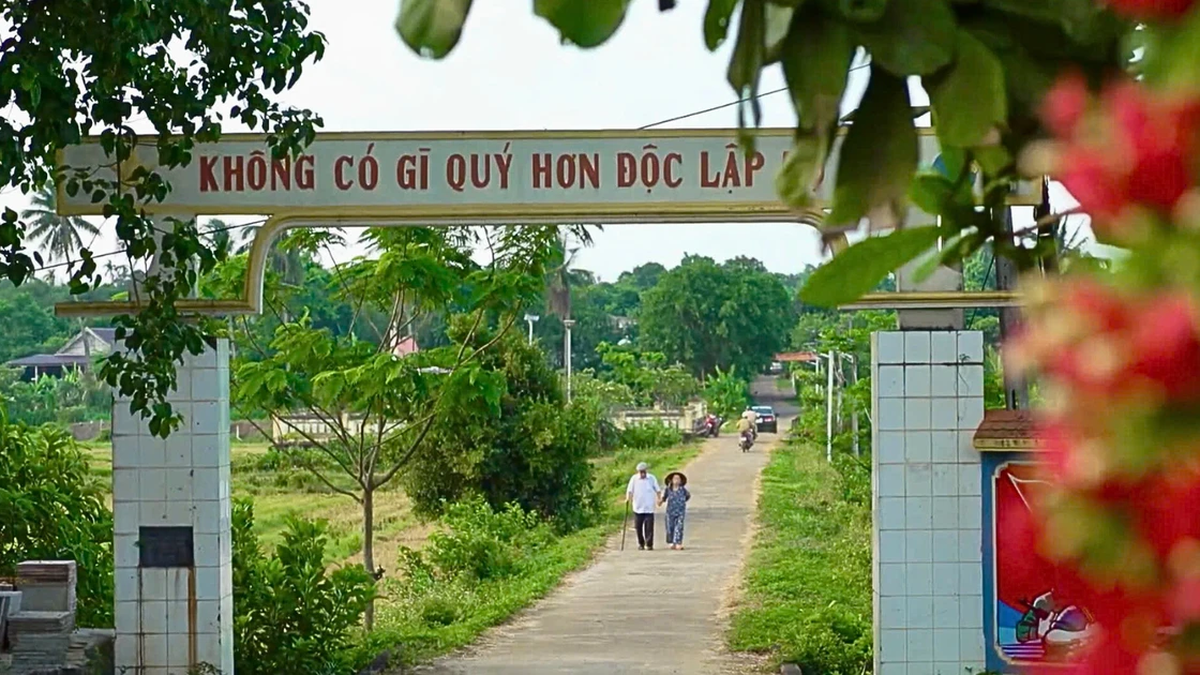
On July 24, the Ministry of National Defense mobilized two helicopters from the Northern Helicopter Company and Regiment 916 to carry out emergency relief missions for isolated people in the western region of Nghe An (Photo: VNA)
After a series of severe natural disasters that occurred in 2024, especially the historic flood after storm No. 3 (Yagi), the largest since 1971, or the "flood with a frequency of only once every 5,000 years" in Nghe An that recently occurred after storm No. 3 (Wipha), Deputy Minister of Agriculture and Environment Nguyen Hoang Hiep emphasized that strengthening the natural disaster prevention and control posture in a more proactive direction, suitable for two-level government, is an urgent solution.
Strengthening disaster prevention from the grassroots
Speaking at the first meeting of the National Civil Defense Steering Committee on natural disaster prevention and search and rescue in 2025, which took place this afternoon, July 24, Mr. Hiep said that according to forecasts, in 2025, there will likely be about 8-11 storms and tropical depressions in the East Sea (of which 3-5 will make landfall), concentrated mainly at the end of the year.
With the above meteorological developments, the hydrometeorological agency forecasts that floods on rivers from Quang Binh to Khanh Hoa and small rivers and streams in the North will be at alert level 2-3; risk of flooding in urban areas and large cities due to local heavy rain; flash floods and landslides are at high risk in mountainous provinces.
Therefore, in order to promptly prevent and combat natural disasters, Mr. Hiep said that one of the top priority tasks is to promptly review, supplement and perfect the system of legal documents on natural disaster prevention and combat to suit the reality and the two-level local government model.
Mr. Hiep also emphasized the need to complete the set of operating regulations for natural disaster prevention and control of the National Civil Defense Steering Committee and Civil Defense Command Committees at all levels; to perfect the agencies assisting the steering committees and commands in natural disaster prevention and control at all levels, ensuring continuous and effective operations, inheriting existing agencies, avoiding overlaps, and not allowing interruptions in directing and advising on disaster response, especially at the commune-level Civil Defense Command Committees.
Regarding the work of preventing and controlling natural disaster risks, Mr. Hiep emphasized the need to continue implementing the National Strategy for Natural Disaster Prevention and Control; National Natural Disaster Prevention and Control Plan; National Comprehensive Program for Natural Disaster Prevention and Control; Project to raise public awareness and community-based natural disaster risk management...
Along with that, it is necessary to integrate the content of natural disaster prevention and control into socio-economic development planning and plans, investment programs and projects of ministries and local branches, especially projects on infrastructure development, transportation, new urban areas, and concentrated residential areas; issue and implement the Project on prevention and control of subsidence, landslides, flooding, drought, and saltwater intrusion in the Mekong Delta; and the Project on prevention and control of landslides, flash floods, and flash floods in the Central region and the Northern mountainous region.

In particular, localities need to review, update and supplement disaster prevention and control plans, disaster response plans according to local authorities at two levels and arrange provincial administrative units; organize inspections, assessments, identify key points, prepare for disaster response, and ensure the safety of dike systems, dams and works.
Upgrading forecasting, people-centric
To effectively respond, Mr. Hiep also paid special attention to improving the quality of forecasting, warning, monitoring and supervision of natural disasters to meet the requirements of directing and operating; promptly informing local authorities at all levels to proactively respond; completing the work of building maps of natural disaster risk zoning, maps of flash flood and landslide risks to the village and hamlet level in key areas.
The main spirit throughout 2025 is to build and effectively operate a "national disaster prevention posture," with people as the center and the commune level as the foundation.
Therefore, localities are required to develop realistic scenarios, linked to terrain, population, and infrastructure characteristics, focusing on situations that exceed design requirements such as extremely heavy rain and floods, emergency spillway discharges, or prolonged urban flooding.
“We must be really close to the people and close to reality. Response scenarios cannot be general. Lessons from storm No. 3 last year show that places that have good plans can still limit damage even when the storm is strong,” Mr. Hiep especially noted.
With that spirit, Mr. Hiep recommended increasing resources, investing in equipment, improving the quality of forecasting and warning, ensuring the requirements for early, timely and accurate forecasting and warning of natural disasters, especially those types of natural disasters that frequently occur and cause great damage such as storms, floods, droughts, saltwater intrusion, flash floods and landslides.
Currently, specialized units are continuing to invest in rain monitoring systems, water monitoring systems, and risk warning maps down to the commune level; the application of satellite imaging technology, artificial intelligence, and drones will also be promoted this year.
At the same time, Mr. Hiep also emphasized the importance of communication work. Accordingly, he expressed the view that relevant ministries and branches, especially specialized agencies, need to strengthen close coordination with news agencies and newspapers to communicate and bring news about natural disasters, response and recovery work "quickly, deeply, closely" to authorities at all levels and people.
Mr. Hiep also expressed the view that it is necessary to prioritize resources for overcoming the consequences of natural disasters; localities should focus on directing, inspecting, and urging to ensure the quality and progress of projects to arrange and stabilize residents in disaster areas, overcome and repair incidents and damage to disaster prevention and control works, dikes, reservoirs, and essential infrastructure caused by storms and floods; allocate resources to localities to ensure the right purpose, target and resource efficiency./.
| At the first meeting of the National Civil Defense Steering Committee on natural disaster prevention and control and search and rescue in 2025, Minister and Head of the Government Office Tran Van Son announced the Prime Minister's Decision on reorganizing from 3 Steering Committees, including: National Civil Defense Steering Committee; National Steering Committee on natural disaster prevention and control; National Committee for incident response, natural disasters and search and rescue into the National Civil Defense Steering Committee. | |
Source: https://baolangson.vn/tu-tran-lu-lich-su-sau-con-bao-so-3-nang-cap-the-tran-phong-chong-thien-tai-5054239.html



































































































Comment (0)